Children's Audiology Services
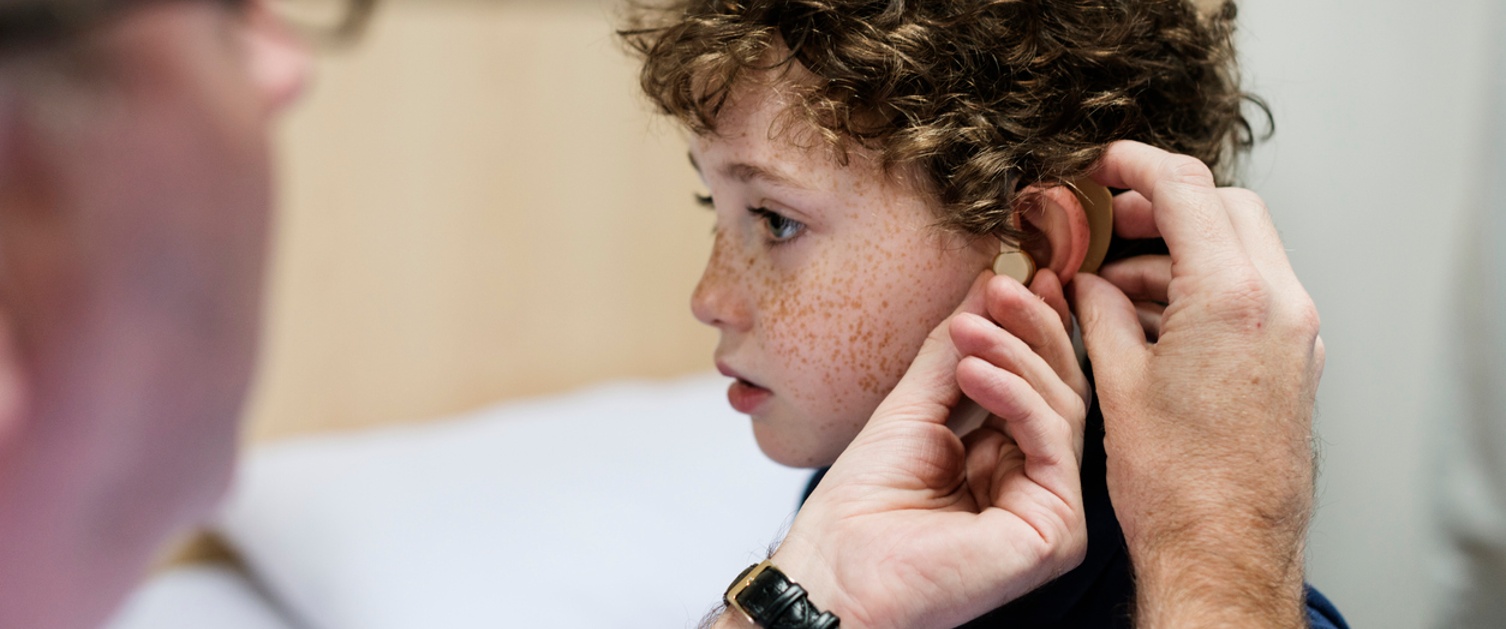
Audiologists in the Paediatric Audiology department can:
- Perform hearing tests
- Tell you about the type and level of hearing loss that your child has
- Provide and manage hearing aids
- Provide earmoulds for your child’s hearing aids
- Refer to education support services
- Work with other professionals, such as Ear, Nose and Throat (ENT) doctors and teachers of the hearing impaired.
If you are concerned about a child’s hearing, Audiology accepts referrals from GPs, Health Visitors, School Health Nurses and other Health professionals. If your child is already under the Audiology service and you are concerned there has been a change in hearing, you can contact Audiology directly.
Mid and South Powys
Paediatric Audiology Services are based at Brecon War Memorial Hospital. We may be able to offer your child an appointment at Llandrindod Wells or Ystradgynlais Hospitals.
Contact details:
Telephone: 01874 615691
Text: 07970 250 854
Email: PaediatricAudiologyService@wales.nhs.uk
Postal Address: Audiology Department, Brecon War Memorial Hospital, Cerrigcochion Road, Brecon, Powys LD3 7TJ
North Powys
Audiology Services for patients living in North Powys are provided by Betsi Cadwaladr University Health Board, and delivered from Newtown Hospital and Welshpool Hospital.
You can find more information about audiology services in North Powys here.
Wrexham Maelor Hospital: 01978 725304
Due to COVID19 restrictions, we are not currently able to run our Open Access Repairs Services.
Follow this trouble shooting guide:
Your hearing aid does not work at all
- Check the hearing aid is switched on and at the correct volume
- Check the battery - if it is a new one check that it is in the right way. If it is old, replace it.
Whistling noise (sometimes called feedback)
- Check that the hearing aid earmould is inserted properly and reposition if necessary.
- Check the earmould, if it is loose or cracked it may cause whistling. If this is the case, a new mould will need to be made.
- If the mould is ok, but the hearing aid is still whistling in the ear, it may be due to wax. Clean the earmould and consider administering olive oil to the ear at night to help resolve the wax.
Buzzing or crackling sound
- Check the battery.
- Inspect the casing of the hearing aid, if you notice cracks, the hearing aid may have become faulty and will need replacing.
Crackling noise/sound comes and goes
- The hearing aid may be intermittent if the battery connection is loose.
See the links below for videos and instructions demonstrating basic troubleshooting and servicing.
Hearing Aid with Custom Earmoulds:
You can find a troubleshooting video here.
You can find a video guide to retubing your earmould here.
You can find a step-by-step guide to retubing your earmould here.
You can find a step-by-step guide to inserting and removing your earmould here.
Mid and South Powys hearing aid repairs
We are conducting hearing aid repairs by postal service where possible. If you are having a problem with your hearing aid, telephone, text or email our Audiology Department in the first instance, where we will troubleshoot and attempt to solve the problem over the phone. Many patients are now receiving tubes and spare parts for their hearing aids by post, and carrying out their own minor repairs at home.
If we are not able to resolve the issues, we can book a children’s hearing aid repair appointment at Brecon War Memorial Hospital or Llandrindod War Memorial Hospital. If your child requires a new mould to be made, we will arrange an appointment for this.
Hearing Aid Batteries
If you require batteries, please contact us by telephone, text or email, advising whether you wear one or two hearing aids, and what colour stickers are on your batteries, and we will post them 1st class on the same day.
North Powys Hearing Aid Repair Service
Audiology Services for patients living in North Powys are provided by Betsi Cadwaladr University Health Board, and delivered from Newtown Hospital and Welshpool Hospital.
You can find more information about audiology services in North Powys here.
Wrexham Maelor Hospital: 01978 725304
Due to COVID19 restrictions, there is currently no Open Access Repairs Service available. Hearing aid repairs are being carried out by postal service where possible. Please visit the website above or ring the Audiology department on the number above. We will arrange for a clinician to phone you back and guide you through some fault finding or ask you to post in the device for repair. See the links above for videos and instructions demonstrating basic troubleshooting and servicing.
Hear to Help
RNID Hear to Help are offering a drop off hearing aid clinic in place of their previous walk-in community sessions.
RNID are not able to see patients face to face within the clinic, the service is a distanced, drop-off model, with hearing-aids being left with a member of their team outside the location, and then repaired inside. People will be asked to wait in their vehicles or return at a specified time.
- Newtown clinic at Plas Dolerw
Milford Rd, Newtown SY16 2EH
4th Tuesday of every month 10am-1pm
- Llandrindod Wells clinic at Rock Park Spa.
Park Terrace, Llandrindod Wells LD1 6AU
2nd Monday of the month 10am-1pm
- Knighton clinic at The Comm
Bowling Green Lane, Knighton LD7 1DR
3rd Tuesday of the month 10am-1pm
- Ystradgynlais at the Welfare Hall
Brecon Road, Ystradgynlais SA9 1JJ
4th Wednesday of the month 10am-1pm (Starting May)
- Brecon at Kensington hall
Kensington Terrace, Brecon LD3 9AY
2nd Wednesday of the Month 10am-1pm (Hope to start 9th June)
To keep staff, volunteers and NHS hearing-aid users safe, the service has introduced the following requirements:
- Hearing-aids must be placed in a labelled envelope with a name, issue and contact details for return.
- A member of the RNID team will collect the envelope from the client, outside the venue.
- Clients will be asked to wear masks when handing over their aid.
- Clients can either wait in their vehicle or return later to pick up their hearing aids. They will not be allowed to wait inside the premises.
- Hearing-aids can be dropped off by friends or family on behalf of a user.
In addition to the new distanced sessions, RNID continues to support NHS hearing aid users over the phone and by email. For more information:
Call Rachael Beech on 07552165800 or email Rachael.beech@rnid.org.uk
Or contact the RNID Information Line:
Call 0808 808 0123
Email information@rnid.org.uk
Text message 0780 000 0360
Relay UK 18001 then 0808 808 0123
Textphone 0808 808 900
Who’s Who?
Below is some basic information about the most common services and professionals you might meet.
Audiology
Audiologists in the Audiology department can:
· Perform hearing tests
· Tell you about the type and level of hearing loss that your child has
· Provide and manage hearing aids
· Provide earmoulds for your child’s hearing aids
· Refer to education support services
· Work with other professionals, such as Ear, Nose and Throat (ENT) doctors and teachers of the hearing impaired.
Ear, Nose and Throat (ENT)
Your child may also see an Ear, Nose and Throat Doctor (ENT) who specialises in the diagnosis and medical or surgical management of disorders, diseases and injuries of the ear, nose and throat.
If you are referred to ENT, the doctor may look into the cause of your child’s deafness and carry out any medical tests that are needed. You may also see an ENT doctor if, for example, your child has glue ear or recurrent ear infections which may be managed by grommets.
Educational Sensory Support Services
Sensory Support Services are part of the local authority and they provide services to deaf children and their parents. The support can be provided by Teachers of the Hearing Impaired in the child’s home, at nurseries and playgroups or in schools and colleges.
Your child’s Teacher of the Hearing Impaired can provide support to children and families in the following areas:
· Assessing educational needs for your child
· Ensuring teaching staff are aware of your child’s needs
· Language and communication
· Issues relating to being the parent of a deaf child
· Getting places in nurseries, playgroups and schools
Other parents
If you would like to, you can meet other parents or carers of children with hearing loss. More information can be found via the National Deaf Children’s Society (NDCS)
Parts of your child’s hearing aid
A hearing aid has four main parts:
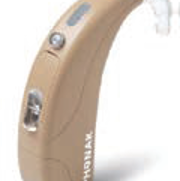 Aid
Aid
|
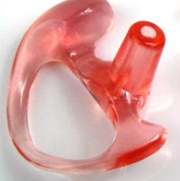
|
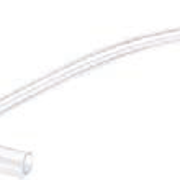
|
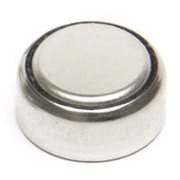
|
| Aid | Earmould | Tubing | Battery |
Earmould Cleaning
It is important to keep your child’s earmould clean and free from wax, so once a week it needs to be cleaned.
- Separate the hearing aid from the earmould by pulling the flexible plastic tube away from the hooked part of the aid. Take care not to pull the tubing out of the mould.
- Wash the earmould and tube in warm soapy water. Use a nailbrush to remove any wax from the tube.
- Rinse the earmould in clean water. Shake the tubing to remove any water to make sure no droplets are left in it.
- Leave the earmould and the attached tubing to dry in a warm place.
When you are sure that the earmould is dry, put it back onto the hearing aid. Make sure that the curve of the mould is in the same direction as the curve of the hearing aid
Inserting the earmould
Inserting the earmould can be tricky until you are used to it. Take your time and practice to make sure that it is correctly fitted in your child’s ear. If your child is older, they may be able to fit the earmould themselves, but they may need help to begin with.
The most common fault is failure to get the top point behind the ridge of skin at the top of the ear, which may cause the aid to whistle and feel uncomfortable.
To insert,
- hold the back curve of the earmould between the index finger and the thumb
- Take the earmould towards the back of the ear and push it forwards
- The hearing aid can then be lifted behind the ear.
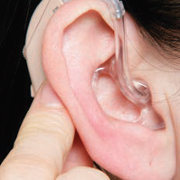
|
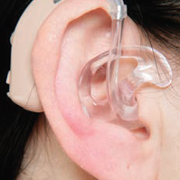
|
| Correctly inserted earmould |
Incorrectly inserted earmould |
Replacing the tubing in your child’s earmould
Every 5-6 months the tubing in your child’s earmould will need replacing. To do this, follow these simple steps. If you are unable to complete this yourself, please arrange an appointment.
1. Pull the tubing out of the earmould and keep it - you will need it later
2. Take a new piece of tubing and taper one end so you can thread it right through the canal in the earmould
3. Pull the point of the plastic that emerges at the tip until the opposite end of the tubing is standing roughtly upright
4. Cut off the tapered end, making it smooth
5. Using the old piece of tubing as a template, measure the correct length of the tubing. Cut as shown.
6. The earmould should be re-attached to the hearing aid with the curve of the mould matching the curve of the aid.
These video links may help:
http://c2hearonline.com/custom_mould/troubleshooting.html
http://c2hearonline.com/custom_mould/retubing.html
Tips on getting your child to wear their hearing aid (s)
Try to make wearing hearing aids part of your child’s dressing and undressing routine. Put them in when they get up and take them our when they go to bed. It will become normal for your child to wear their hearing aids when they are awake.
Let your child have choices. Ask them if they are going to wear the hearing aids. Perhaps offer them two of their favourite things to choose from as rewards when they wear their hearing aids.
Have something to distract your child, such as a favourite toy. Perhaps you could even have a special toy that they only have when you are putting the hearing aids in.
Slowly build up the length of time that your child wears their hearing aids. Depending on how your child is taking to the hearing aid, you could start with a couple of minutes several times a day. It’s all about quality usage but the more your child wears the aid the better.
Keeping the hearing aids in place
Behind the ear hearing aids can sometimes be difficult to keep in place on babies and small children. Sometimes sticky pads (between the hearing aid and the skin behind the ear) can help to hold the hearing aid in place. These can be issued from the Audiology Department. Hearing aid retainers, also called ‘huggies’ are also available. These are thin plastic tubes that go around the ear. Attached to the tube are two circular bands of plastic which are pushed over the hearing aid and keep it in place.
If you are worried about your child losing their hearing aids, you could try clips, which attach to their clothing (this can also be provided by your audiologist).
It is important to ensure your child has well fitting earmoulds to help reduce whistling and to ensure the hearing aids are comfortable. If you think your child needs new ear-moulds because they are loose or cracked, please attend the drop-in clinic (Brecon Hospital 9-12noon every Wednesday and Llandrindod Hospital every Tuesday 1-3.30pm) or let us know at an upcoming appointment.
When things go wrong
Your hearing aid does not work at all
· Check the hearing aid is switched on and at the correct volume
· Check the battery - if it is a new one check that it is in the right way. If it is old, replace it.
Whistling noise (sometimes called feedback)
· Check that the hearing aid earmould is inserted properly and reposition if necessary.
· Check the earmould, if it is loose or cracked it may cause whistling. If this is the case, a new mould will need to be made.
· If the mould is ok, but the hearing aid is still whistling in the ear, it may be due to wax. Clean the earmould and consider administering olive oil to the ear at night to help resolve the wax.
Buzzing or crackling sound
· Check the battery.
· Inspect the casing of the hearing aid, if you notice cracks, the hearing aid may have become faulty and will need replacing.
Crackling noise/sound comes and goes
· The hearing aid may be intermittent if the battery connection is loose.
If you have made all the above checks and the aid is still not working, it may be faulty. Contact the Audiology Department
Communication tactics
A few tips for improving listening environments (where possible):
- Make sure you are facing your child and maintaining good eye contact. Try to be on the same level as them and allow some space for signing or lip-reading. (So, keep a distance of about 1-2 metres between you and your child).
- Use a well-lit room and don’t have your back to a window, as this creates shadow and makes it difficult to read facial expressions or lipread.
- Speak clearly, naturally and at a normal pace.Don’t shout, as it can appear to your child that you are angry and it also distorts lip patterns.
- Try to make sure that background noise is kept to a minimum. Children with hearing aids may find it particularly difficult to pick out what is being said. A room that is carpeted or curtained will help to cut down the effects of noise in a room.
- Use your hands and facial expressions to gesture and support what you are saying.
Technology and Assistive Devices
There is a wide range of equipment that can be useful for young hearing aid users. Some equipment is designed to make children more independent around the home and others is designed to work with the hearing aids to overcome some of the problems caused by background noise. Your Audiologist will inform you of equipment that may be useful for you and your child. Any questions, please ask.
Equipment can be trialled at home as part of the NDCS “Technology Test Drive” scheme. For more information, contact the NDCS (please see further down).
FM Systems
FM systems are sometimes known as “radio aids”. FM systems are most beneficial in the classroom when there is background noise, but they can also be used around the home. The Sensory Support Team will consider your child’s suitability for an FM system and organise this if appropriate. Speak to your Audiologist if you want to find out more.
Hearing aid repairs and new ear moulds
If your child’s hearing aid is not working or they require a new earmould, you can do any of the following:
- Telephone, text or email our Audiology Department
We will troubleshoot and attempt to solve the problem over the phone. Many patients are now receiving tubes and spare parts for their hearing aids by post, and carrying out their own minor repairs at home.
- Post the hearing aids to our department
We offer a postal repair service in Brecon Hospital. Just send the hearing aid to Audiology department, Brecon Hospital, Cerrigcochion Road, Brecon, LD3 7NS. Include your child’s details and a note of what the problem is.
- Book an appointment
Book a children’s hearing aid repair appointment at Brecon War Memorial Hospital or Llandrindod War Memorial Hospital by telephoning 01874 615691 or emailing PaediatricAudiologyService@wales.nhs.uk
To get batteries:
Replacement batteries can be obtained by the following ways:
1. From your GP surgery, please take the brown book or battery card with you.
2. From your local hospital, please take the brown book or battery card with you
· Brecon War Memorial Hospital Main reception desk or Audiology Department
· Llandrindod War Memorial Hospital Main reception desk
3. By post - Send the brown book or battery card with your request for batteries. They will be sent by return of post.
4. By phone - Telephone 01874 615691 to request batteries to be sent by post.
5. Text 07970 250 854 with name, address, and size batteries you require.
6. Email: PaediatricAudiologyService@wales.nhs.uk with name, address and size batteries you require.
Battery safety
It is dangerous for a child to swallow a battery. Young children can also get small batteries stuck in their nose and ears. Make sure you do the following:
· Store batteries in a safe place, out of reach from children.
· Leave your child’s hearing aid in a safe place, when it is not in use.
· Dispose of used batteries carefully. Our Audiology Department recycles batteries.
· Try not to let young children see batteries being changed. It is safer if they do not know that the battery compartment opens.
Your child’s hearing aid can also be “tamperproof”. This means that it can be set up so that the battery compartment cannot be opened by your child. Your Audiologist should have shown you how the “tamperproof” feature works on your child’s hearing aid at their fitting appointment. If you are unsure of how to lock the battery compartment, please refer to the child’s hearing aid instruction booklet or contact your Audiologist for instructions on how to do this.
General Advice
Using the telephone - the telephone earpiece should be placed near the top of the hearing aid, close to the microphone. Hold it an inch away from the ear if it causes whistling.
Change the hearing aid batteries on a regular basis (batteries can last up to 10 days if the hearing aids are used full-time), we would recommend changing once per week.
When you turn the hearing aid on, before putting it in your child’s ear, cup it in your hands and check to see if the hearing aid whistles - this will indicate that the hearing aid has been turned on properly.
Useful contacts and websites
National Deaf Children’s Society
A UK charity dedicated to providing support, information and advice for deaf children, young people and families. The NDCS can provide assistive equipment for you to trial as part of their “technology test drive” scheme; they can also support you in applications for DLA. The Audiology Department stocks a wide range of NDCS and other leaflets.
Speak to your Audiologist if you want to find out more or check out the leaflet stand in the Children’s Hospital waiting area and our Paediatric Audiology information board opposite our Audiology room at Brecon War Memorial Hospital.
Also check out their videos on how to look after hearing aids on their YouTube page.
Freephone helpline number: 0808 800 8880 or www.ndcs.org.uk
Join our local NDCS group!
Make friends with other families with deaf and partially hearing
children:
2 South, Ty-Nant Court, Morganstown, Cardiff, CF15 8LW.
Tel: 02920 373474,
Minicom: 02920 811861,
email: ndcswales@ndcs.org.uk Or northpowys_dcs@yahoo.com
The NDCS also provide a very useful seasonal magazine for of useful information called Families: magazine@ndcs.org.uk or telephone Freephone 0808 800 8880
Contact us
Paediatric Audiology
Audiology Department
Brecon War Memorial Hospital
Cerrigcochion Road
Brecon
LD3 7NS
Tel (01874) 615691
Email: PaediatricAudiologyService@wales.nhs.uk
Disability Living Allowance (DLA) Some children are suitable for DLA financial support. Ask your Audiologist if you require a supporting statement and contact the NDCS for further information (www.ndcs.org.uk, 2 South, Ty-Nant Court, Morganstown, Cardiff, CF15 8LW. Tel: 02920 373474, Minicom: 02920 811861, email: ndcswales@ndcs.org.uk)
We appreciate and encourage feedback. If you need advice or are concerned about any aspect of your care or treatment please speak to a member of staff.
What will happen at the appointment?
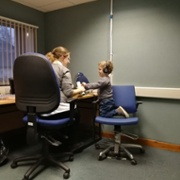
At the start of the appointment we will ask you a few questions about how you feel your child is hearing, their development and questions about their health and ear health.
During the appointment we like to have a look in your child’s ears, this is to check for wax and that their ear drums are looking healthy.
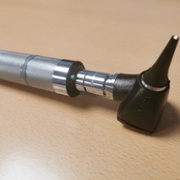
Sometimes we will do this at the start of the appointment and sometimes at the end. To do this we use a light with a little magnifier (pictured)
How will we test the hearing?
The way that we test the hearing can change depending on each child and their abilities but we always try and make our tests like we are playing games.
Sometimes we will use speakers to play sounds and sometimes we will use different types of headphones.
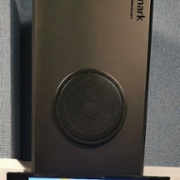
|

|
If you have headphones similar to these at home then you could try out with your child so they are more used to having headphones on. Maybe try them with a TV program they like to watch.
We will then see whether your child will respond to the sounds we play. This might be turning to see a fun animation on the screen, asking your child to pop a man in the boat when they hear him whistle, pressing a button when they hear a sound or repeating different words that they hear.
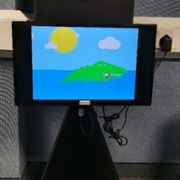
|
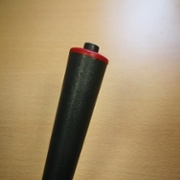
|
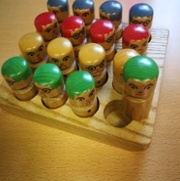
|
Don’t worry if your child doesn’t respond to the sounds first time or is not picking up how we are testing, sometimes we need to change tests or change how we are testing.
Sometimes we may even just play lots of different sounds around your child and see if they will turn to see what the sound is or make a response.
We often do a little check on your child’s eardrums. This checks for any blockages in the ear. This doesn’t hurt and often tickles.
At the end of the appointment we like to discuss the test results with you. In some appointments we can get all the test results in one go and can give you a good indication of your child’s hearing. Sometimes it can take us a few appointments in order to build up a profile of your child hearing.
We will then discuss further options, management or further reviews with you and answer any questions you may have.
Department Contact Details
The Children’s Centre
Brecon Audiology Department
Cerrigcochion Road
Brecon
LD3 7NS
Telephone: 01874 615691
Email Address: PaediatricAudiologyService.Powys@wales.nhs.uk
- Children's Audiology Reports and Results
-
All NHS audiology services in Wales have an annual external audit of adult or paediatric audiology services.
The most recent reports can be found by clicking the link above.